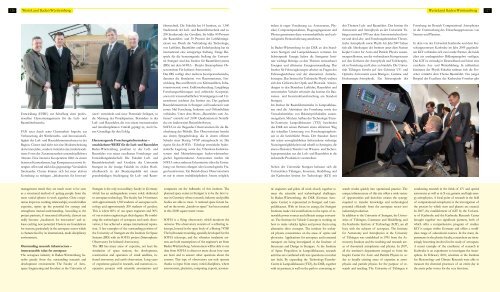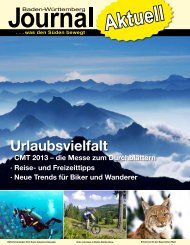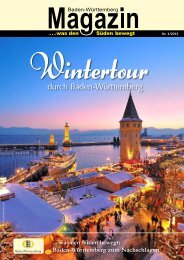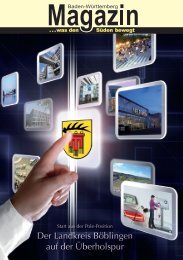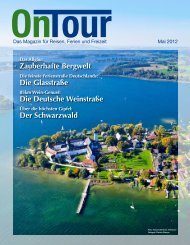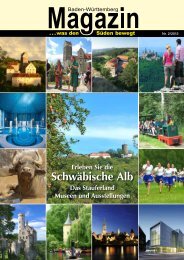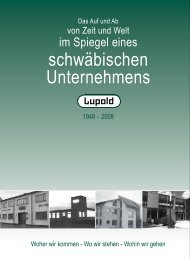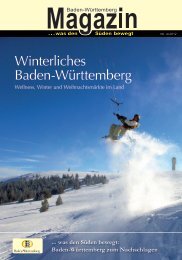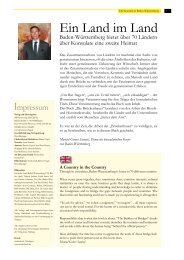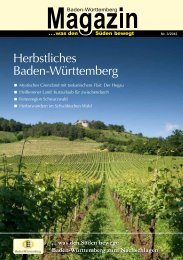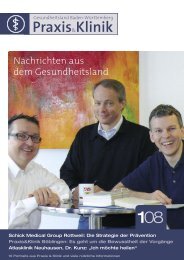WerteLand Baden-Württemberg - PR Presseverlag Süd GmbH
WerteLand Baden-Württemberg - PR Presseverlag Süd GmbH
WerteLand Baden-Württemberg - PR Presseverlag Süd GmbH
Sie wollen auch ein ePaper? Erhöhen Sie die Reichweite Ihrer Titel.
YUMPU macht aus Druck-PDFs automatisch weboptimierte ePaper, die Google liebt.
126 <strong>WerteLand</strong> <strong>Baden</strong>-<strong>Württemberg</strong><br />
Entwicklung (EFRE) zur Schaffung eines profes-<br />
sionellen Clustermanagements für die Luft- und<br />
Raumfahrtbranche.<br />
FAN setzt durch seine Clusterarbeit Impulse zur<br />
Verbesserung der Wettbewerbs- und Innovationsfähigkeit<br />
der Luft- und Raumfahrtunternehmen in der<br />
Region. Cluster sind nicht nur eine Modeerscheinung<br />
der letzten Jahre, sondern vielmehr eine institutionalisierte<br />
Form der Zusammenarbeit unterschiedlichster<br />
Akteure. Eine intensive Kooperation führt zu einem<br />
besseren Kennenlernen, legt Kompetenzen sowie Synergien<br />
offen und stärkt das gegenseitige Verständnis<br />
füreinander. Cluster können sich bei einer aktiven<br />
Gestaltung zu richtigen „Inkubatoren für Innovati-<br />
management trend: they are much more to be seen<br />
as a structured method of getting people from the<br />
most varied spheres to work together. Close cooperation<br />
improves working relationships, reveals hidden<br />
expertise, opens up the potential for synergy and<br />
strengthens mutual understanding. According to the<br />
project partners, if structured effectively, clusters can<br />
really become „incubators for innovation“ and release<br />
exciting new potential. Clusters are foundations<br />
for success, particularly in the aerospace sector which<br />
is characterised by its international, multi-disciplinary<br />
environment.<br />
Outstanding research infrastructure –<br />
immeasurable value for aerospace<br />
The aerospace industry in <strong>Baden</strong>-<strong>Württemberg</strong> benefits<br />
greatly from the outstanding research and<br />
development environment: The Faculty of Aerospace<br />
Engineering and Geodesy at the University of<br />
onen“ entwickeln und neue Potenziale freilegen, so<br />
die Meinung der Projektpartner. Besonders in der<br />
Luft- und Raumfahrt, die von einem internationalen<br />
und interdisziplinären Umfeld geprägt ist, sind Cluster<br />
Grundlage für den Erfolg.<br />
Herausragende Forschungsinfrastruktur –<br />
unschätzbarer WERT für die Luft- und Raumfahrt<br />
<strong>Baden</strong>-<strong>Württemberg</strong> profitiert in der Luft- und<br />
Raumfahrt von seiner exzellenten Forschungs- und<br />
Entwicklungslandschaft: Die Fakultät Luft- und<br />
Raumfahrttechnik und Geodäsie der Universität<br />
Stuttgart ist die einzige Fakultät im zivilen Hochschulbereich<br />
in der Bundesrepublik mit einem<br />
grundständigen Studiengang für Luft- und Raum-<br />
Stuttgart is the only non-military faculty in Germany<br />
which has an undergraduate course solely dedicated<br />
to aerospace technology. The faculty has 14 institutes<br />
with approximately 1,300 students of aerospace technology<br />
and approximately 200 students of geodesy.<br />
This is where 80% of our space engineers and 30%<br />
of our aviation engineers get their degrees. By combining<br />
the technologies of aerospace and earth observation,<br />
it has achieved a unique international reputation.<br />
A few examples of the outstanding position of<br />
the University of Stuttgart are the Institute for Space<br />
Systems (IRS) with its SOFIA project (Stratospheric<br />
Observatory for Infrared Astronomy).<br />
The IRS has many areas of expertise, not least the<br />
simulation of space stations, the development,<br />
construction and operation of small satellites, in-<br />
frared astronomy and earth observation. Long years<br />
of experience gained in research, and numerous co-<br />
operative projects with scientific associations and<br />
fahrttechnik. Die Fakultät hat 14 Institute, ca. 1.300<br />
Studierende der Luft- und Raumfahrttechnik und ca.<br />
200 Studierende der Geodäsie. Sie bildet 80 Prozent<br />
der Raumfahrt- und 30 Prozent der Luftfahrtinge-<br />
nieure aus. Durch die Verbindung der Technologie,<br />
von Luftfahrt, Raumfahrt und Erderkundung hat sie<br />
international eine einzigartige Stellung. Einige Beispiele<br />
für die herausragende Stellung der Universität<br />
Stuttgart sind das Institut für Raumfahrtsysteme<br />
(IRS) mit dem SOFIA - Projekt (Stratosphären Observatorium<br />
Für Infrarot-Astronomie).<br />
Das IRS verfügt über mehrere Kompetenzbereiche,<br />
darunter die Simulation von Raumstationen, Entwicklung,<br />
Bau und Betrieb von Kleinsatelliten, Infrarotastronomie<br />
sowie Erdfernerkundung. Langjährige<br />
Forschungserfahrungen und zahlreiche Kooperationen<br />
mit wissenschaftlichen Vereinigungen und Unternehmen<br />
zeichnen das Institut aus. Das geplante<br />
Raumfahrtzentrum in Stuttgart soll bundesweit zum<br />
ersten Mal Forschung, Industrie und Öffentlichkeit<br />
verbinden. Unter dem Motto „Raumfahrt zum Anfassen“<br />
entsteht auf 2.000 Quadratmetern Nutzfläche<br />
ein landesweites Raumfahrtforum.<br />
SOFIA ist ein fliegendes Observatorium für die Beobachtung<br />
des Weltalls. Das Observatorium besteht<br />
aus einem Spiegelteleskop, das in einem offenen<br />
Schacht einer Boeing 747SP untergebracht ist. Die<br />
eigens für das SOFIA - Teleskop entwickelte hydrostatische<br />
Lagerung sowie das Vibrations-Isolationssystem<br />
sind Meisterleistungen baden-württembergischer<br />
Ingenieurskunst. Astronomen werden mit<br />
SOFIA unter anderem Erkenntnisse über die Entste-<br />
hung von Sternen erlangen oder kosmologische Fragen<br />
beantworten. Ein Betrieb dieses Observatoriums<br />
ist nur in einem multidisziplinären Ansatz möglich,<br />
companies are the hallmarks of this institute. The<br />
planned space centre in Stuttgart is to be the first venue<br />
in Germany where research, industry and public<br />
bodies are able to meet. A national space forum based<br />
on the motto „hands-on space“ has been created<br />
in this 2,000 square meter venue.<br />
SOFIA is a flying observatory which monitors the<br />
universe. The observatory consists of a reflecting telescope,<br />
housed in the open body of a Boeing 747SP.<br />
The hydrostatic mounting, specially developed for the<br />
SOFIA telescope, and the vibration insulation system,<br />
are both masterpieces of the engineer‘s art from<br />
<strong>Baden</strong>-<strong>Württemberg</strong>. Astronomers will be able to use<br />
data from SOFIA to discover more about how stars<br />
are born and to answer other questions about the<br />
cosmos. This type of observatory can only operate<br />
thanks to input from many varied disciplines, where<br />
astronomers, physicists, computing experts, aeronau-<br />
indem in enger Verzahnung u.a. Astronomen, Physiker,<br />
Computerspezialisten, Flugzeugingenieure und<br />
Piloten gemeinsam diese wissenschaftliche und technologische<br />
Herausforderung annehmen.<br />
In <strong>Baden</strong>-<strong>Württemberg</strong> ist das DLR an den Standorten<br />
Stuttgart und Lampoldshausen vertreten. Im<br />
Schwerpunkt Energie liefern die Stuttgarter Institute<br />
wichtige Beiträge zu den Themen erneuerbarer<br />
Energien und effizienter Energieumwandlung. Das<br />
Institut für Fahrzeugkonzepte arbeitet an Fragen des<br />
Fahrzeugleichtbaus und der alternativen Antriebskonzepte.<br />
Das Institut für Technische Physik widmet<br />
sich den Gebieten der Optik und Photonik. Anwendungen<br />
in den Bereichen Luftfahrt, Raumfahrt und<br />
terrestrischer Verkehr erforscht das Institut für Bauweisen-<br />
und Konstruktionsforschung am Standort<br />
Stuttgart.<br />
Im Institut für Raumfahrtantriebe in Lampoldshausen<br />
sind die Aktivitäten der Forschung sowie des<br />
Versuchsbetriebes von Raketenprüfständen zusammengefasst.<br />
Mit dem Aufbau des Technologie-Transfer-Zentrums<br />
Lampoldshausen (TTZ) beschreitet<br />
das DLR mit seinen Partnern einen effektiven Weg<br />
der schnellen Umsetzung von Forschungsergebnissen<br />
in die betriebliche Praxis. Der Standort bietet<br />
mit seiner unvergleichlichen Infrastruktur vielseitige<br />
Nutzungsmöglichkeiten und schafft so Synergien, die<br />
einen effizienten Transfer von Wissens- und Technologiepotenzialen<br />
aus der Luft- und Raumfahrt in die<br />
industrielle Produktion vorantreiben.<br />
Neben der Universität Stuttgart befassen sich die<br />
Universitäten Tübingen, Konstanz, Heidelberg und<br />
das Karlsruher Institut for Technologie (KIT) mit<br />
tic engineers and pilots all work closely together to<br />
meet the scientific and technological challenges.<br />
In <strong>Baden</strong>-<strong>Württemberg</strong>, the DLR (German Aerospace<br />
Center) is represented in Stuttgart and Lampoldshausen.<br />
With its focus on energy, the Stuttgart<br />
Institutes make vital contributions to the topics of renewable<br />
power sources and efficient energy conversi-<br />
on. The Institute for Vehicle Concepts is working on<br />
how to make vehicles lighter and power them using<br />
alternative drive concepts. The institute for technical<br />
physics concentrates on the areas of optics and<br />
photonics. Applications for aerospace and terrestrial<br />
transport are being investigated at the Institute of<br />
Structures and Design in Stuttgart. At the Institute<br />
of Space Propulsion in Lampoldshausen, research<br />
activities are combined with test operations on rocket<br />
test beds. By expanding the Technology-Transfer-<br />
Centre in Lampoldshausen (TTZ), the DLR, together<br />
with its partners, is well on the path to converting re-<br />
den Themen Luft- und Raumfahrt. Das Institut für<br />
Astronomie und Astrophysik an der Universität Tübingen<br />
entstand 1995 aus dem Astronomischen Institut<br />
und den Lehr- und Forschungsbereichen Theoretische<br />
Astrophysik sowie Physik. Im Jahr 2007 haben<br />
sich alle Abteilungen des Instituts unter dem Namen<br />
Kepler Center for Astro and Particle Physics zusammengeschlossen,<br />
um die vorhandenen Kompetenzen<br />
auf den Gebieten der Astrophysik und Teilchenphysik<br />
in Forschung und Lehre zu bündeln. Die Universität<br />
Tübingen forscht auf den Gebieten UV- und<br />
Optische Astronomie sowie Röntgen-, Gamma- und<br />
Hochenergie-Astrophysik. Ein Schwerpunkt der<br />
search results quickly into operational practice. The<br />
unique infrastructure of this site offers a wide variety<br />
of opportunities and therefore creates the synergy<br />
required to transfer knowledge and technological<br />
potential efficiently from the aerospace sector into<br />
industrial production.<br />
In addition to the University of Stuttgart, the Universities<br />
of Tübingen, Constance and Heidelberg, and<br />
the Karlsruhe Institute of Technology (KIT), are all<br />
busy with the subjects of aerospace. The Institute<br />
for Astronomy and Astrophysics at the University<br />
of Tübingen was established in 1995 from the Astronomy<br />
Institute and the teaching and research areas<br />
of theoretical astrophysics and physics. In 2007,<br />
all the institute‘s departments merged to form the<br />
Kepler Center for Astro and Particle Physics in order<br />
to bundle existing areas of expertise in astrophysics<br />
and particle physics for the purpose of research<br />
and teaching. The University of Tübingen is<br />
<strong>WerteLand</strong> <strong>Baden</strong>-<strong>Württemberg</strong> 127<br />
Forschung im Bereich Computational Astrophysics<br />
ist die Untersuchung des Entstehungsprozesses von<br />
Sternen und Planeten.<br />
In dem von der Universität Karlsruhe und dem Forschungszentrum<br />
Karlsruhe im Jahr 2009 gegründeten<br />
KIT verbinden sich zwei starke Partner, die beide<br />
über ein umfangreiches Bildungsangebot verfügen.<br />
Das KIT ist einmalig in Deutschland und bietet eine<br />
exzellente Aus- und Weiterbildung. In zahlreichen<br />
Instituten der Physik-Fakultät widmen sich die Forscher<br />
verstärkt dem Thema Raumfahrt. Ein junges<br />
Beispiel der Exzellenz der Karlsruher Forscher gibt<br />
conducting research in the fields of UV and optical<br />
astronomy as well as in X-ray, gamma and high-energy<br />
astrophysics. A focal point of research in the field<br />
of computational astrophysics is the investigation of<br />
the process by which stars and planets are created.<br />
In 2007, the establishment of KIT by the University<br />
of Karlsruhe and the Karlsruhe Research Center<br />
brought together two significant partners, both of<br />
which offer a comprehensive program of studies.<br />
KIT is unique within Germany and offers a worldclass<br />
range of educational courses. In the many departments<br />
in the physics faculty, researchers are increasingly<br />
becoming involved in the study of aerospace.<br />
A recent example of the excellence of research in<br />
Karlsruhe is an experiment to investigate the stratosphere.<br />
In February 2010, scientists at the Institute<br />
for Meteorology and Climate Research were able to<br />
measure the chemical processes of an entire day in<br />
the arctic polar vortex for the very first time.


